
Christchurch shooting has been a popular news topic recently. Here, I would like to compare Strait Times to Buzzfeed reports on the news about gun shop that sold ammunition to Christchurch shooting suspect.
To start off, I will briefly discuss each of the publication history and production context.
Strait Times
Founded in 1845, Straight Times began as a printed single-sheet weekly to provide commercial information needed by the Singapore port. It then became a daily newspaper thirteen years after being founded. Now the Strait Times is owned by Singapore Press Holdings with print and digital editions of newspaper. SPH operates different paywall and Strait Times is operated under a metered paywall.
According to BBC Singapore media profile, Singapore Press Holdings, which has close links to the ruling party, dominates the media scenes in Singapore along with MediaCorp. SPH publishes multiple newspaper, magazine and websites, one of its most popular one is Strait Times. The media profile also states websites carrying political content must register with the Media Development Authority. Websites owners and editors are criminally liable to any content deemed to be objectionable. As seen, Singapore media environment is highly controlled.
With reference to Reuter Institute Digital News Report 2018, Strait Times TV, Radio and Printed was ranked first to be weekly viewed by 51 percent of Singaporeans. As for online, Strait Times ranked second after Channel News Asia being weekly viewed by 45 percent of Singaporeans. This shows Strait Times remains one of the top and most popular news company in its industry in Singapore.
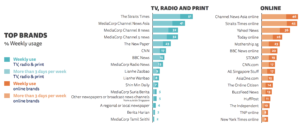
Buzzfeed
Founded in 2006, Buzzfeed is an American independent digital-borne media company. As a global news organisation headquartered in New York, it has over 650 million global audience. Buzzfeed delivers a mix of social, entertainment, breaking news and shareable content. Its business model relies primarily on native advertising in the form of quizzes and video sponsored by companies. It rejects any use of banner or display advertising in favour of promoted posts which makes advertising content look like editorials.
That said, Buzzfeed has been sued by politicians and celebrity in its publication history. One of the most notable stories was the dossier about Russia’s compromising personal and financial information about Trump. The existence of the classified document was reported by mainstream media but was not published as it was unverified. However, Buzzfeed published the 35 pages dossier nearly in-full, remarked it “include[d] some clean errors.” This made multiple politicians sued Buzzfeed for defamation. Though Buzzfeed defended its news only stated facts without opinions, its unsubstantiated posts raised other journalists’ ethical concerns about Buzzfeed.
According to the Digital News Report 2018 stated earlier, Buzzfeed has a relatively low trust score in USA at 4.85 in a score 0-10 for those who have heard of this brand, and at 6.12 for those who uses this brand. The trust score is lower than HuffPost, its digital-borne media competitor. As for weekly use of online news, Buzzfeed ranked 7 compared to HuffPost which ranked first.
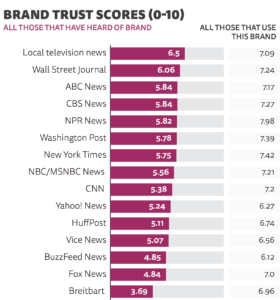
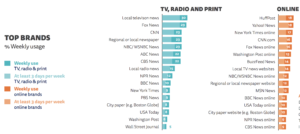
Target Audience and User Demographics
Strait Times news homepage does not reveal its user demographics, so I uses Alexa analytics to measure the demographics in the past 30 days. According to Alexa, 56.6 percent of visitors are from Singapore followed by the US. There are much more female visitors compared to male. Strait Times online has more older audience with the highest number at 65+. In terms of education and income, most visitors achieve graduate school level, with a yearly income $30K-$60K followed by $100+.
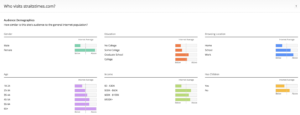
Since the statistics above is released for the past 30 days for global audience only, I searched for more statistics specifically for Singaporeans in 2018. According to Strait Times, the Singapore Media Index 2018 released by Nielsen, print readers had a median age of 48, but among those who read digital version, the largest number is aged between 20-34. Half of the readers were professionals, executives, managers and businessmen from the polled 4688 people aged 15+.
Both results show most readers work for higher occupations which is relative to higher income. However, Alexa reports higher popularity among older visitors online is at odds with the younger readers of digital reported by Strait Times. Perhaps because the latter focus only on Singapore audience in 2018, which includes mobile and tablets.
Buzzfeed news homepage does not reveal its user demographics either. But according to Alexa which measures users demographics globally in the past 30 days, Buzzfeed webpage has the most US visitors at 54.1 percent followed by Japan. Similar to Strait Times, there are much more female visitors than males. However, Buzzfeed visitors have relatively lower education level compared to ST who mostly only achieved college. Also, fewer visitors are from the income group of $100K+ with the highest number at $60K-$100K. Buzzfeed also has visitors mostly aged 18-24. The major difference is that Buzzfeed website has a much more younger audience who do not have children compared to Strait Times website globally. But if we look at the digital landscape of ST in Singapore which includes mobile and tablets, ST also has the highest number of young audience like Buzzfeed. Buzzfeed audience seems to be more socially average in terms of education and income, perhaps the younger group has less earning power than the older professional group.

Finally, it comes to the news analysis between Strait Times’ report and Buzzfeed’s report. Here, I will analyse from the following three different angles.
Journalistic Writing and Content Production
Both Strait Times and Buzzfeed stick to the web-writing concept of brevity. Length of articles are appropriate and each paragraph points to one concept. Writing for a similar topic, Strait Times focus more on Christchurch background information, whereas Buzzfeed gives more details about the gun shop and the owner’s speech at the conference.
Strait Times news angle seems to be more neutral, whereas, Buzzfeed raises controversy, for example, mentioning that “Tipple threatened to sue police” for not allowing the imports of semi-automatic rifles in 2008.

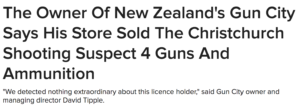
Looking at the headlines, it seems like Buzzfeed tries to create more “buzz” than Strait Times. Instead of stating “suspect bought guns” from the shop, Buzzfeed states the owner “sold the Christchurch suspect 4 guns and ammunition.” Having it “sold” makes “the owner” as a subject in the sentence who seems to be actively involved in the case. Likewise, stating the number of guns being sold highlights the effect of weapon used in the massacre, which captures reader attention. Most of all, Buzzfeed uses quote from the gun owner as a subheading which increases authenticity of the news compared to Strait Times.
Though Buzzfeed headline seems to be more clickable, both news are SEO-friendly. For Strait Times, the keywords “Christchurch shooting” are positioned first in the headline. As for Buzzfeed, perhaps it wants to make emphasis on the gun owner which is why “the owner” is positioned first instead. Even so, more keywords like “New Zealand” and “ammunition” also appear in the headline.
Speaking of links, Strait Times embedded links attribute its sources back to its own news, whereas Buzzfeed links to other media reports. Both also have a comprehensive list of related stories to allow readers understand more about the background. Strait Times incorporates interactive elements on the list of related links. It shows featured photos of stories other than just headlines. Readers can also select to view news story through a horizontal slider.
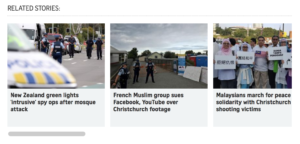
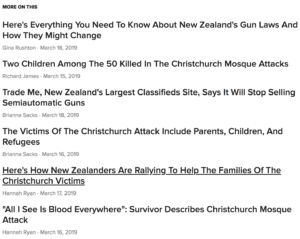
Also, Strait Times includes infographic showing the timeline on the day of Christchurch shooting, and even the map of mosque with footprints of the suspect. These give even more visual background information and details to the readers. As for Buzzfeed, images focus more on the gun owner and shop instead. Though they are relevant with captions, I think uploading a video could better support what the owner says on the news and increase engagement.

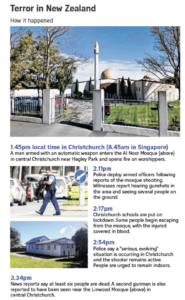
Online Delivery
Compared to Strait Times, Buzzfeed allows readers to interact more with this news and is more transparent with its news organisation.
First, it includes the author name and photo in the byline.
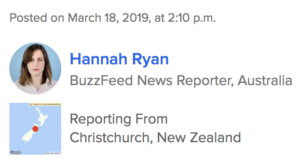
At the end of the page, it shows the author email in case readers have any questions or comments. The email address is directly hyperlinked to the reader’s email for our convenience. What is more? Readers can share tips anonymously. By clicking “submit it here,” it directs us to the page about giving confidential tips and Buzzfeed contacts, like email, address and number. The word “submit” is also a “call-to-action” that invites readers to take desired action.

Meanwhile, Strait Times does not state the author name or contact details but only the publishing date. At first I wonder if the news is taken from Wellington (Reuter) stated at the beginning of the paragraph. But as I look through other news, none of them include author names or contacts. I believe this would decreases the news organisation transparency.
Speaking of social media sharing, both have the icons at the top and bottom bar for readers to share news on social media. Compared to Strait Times, Buzzfeed social media icons are much more noticeable. The icons are bigger and their colour are sharper. Also, they occupy more space at the top bar which highlights its importance compared to ST ones that are smaller in circles at the corner. Meanwhile, Strait Time only has Facebook, Twitter and email icons shown on the page, not until you click the “…” icon to really show the full list of social media.This shows Buzzfeed is more eager to have readers to share this piece of news compared to ST.

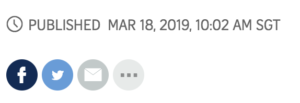
Buzzfeed also has social media sharing icons under each photo and they also appear once hovered upon the photo, which is lacking in ST.

Both both do not include any comment boxes. I think it is because this involves a media-sensitive topic so comments are disabled even in Buzzfeed which normally encourages users to engage and generate content.
Technical Delivery
Both do not have any broken links. While Strait Times uses a more classic font style, Buzzfeed’s are more informal to show that it is a digital-borne media organisation. Meanwhile, the font size of Buzzfeed main texts in body paragraphs are smaller than ST’s, also, their size are even the same as the photo captions’. Font sizes usually highlight the importance of words. Notice that main texts in the news should be more important than photo captions, in this sense, Buzzfeed should either have the caption size smaller or main texts bigger. Here, Strait Time has done this better well to highlight the difference.
Headlines of related links are bolded and even bigger than the main text in Buzzfeed, yet, Strait Time ones are bolded but smaller than the main text. Again, related links only give more background information to readers, content from the main text should carry more weight. Buzzfeed could have shrunk the font size of headlines of related links to better outstand its main texts like how ST does.
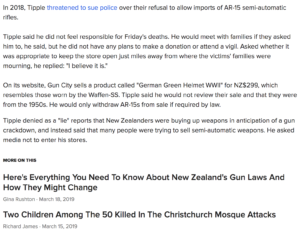
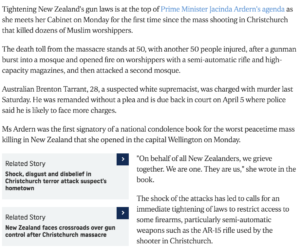
That said, they both have big headlines and visual images. But the infographic of Strait Time could have been bigger, especially the texts inside the graphics. I felt like they were scanned from the print, but anyway the words inside are too small, and especially hardly legible to elder readers.
Speaking of other interface elements, Buzzfeed shows more feedback. For example the color intensity of the social media icons are deepened when hover upon. Likewise, headlines of related links are underlined once hovered upon. These animated feedback tells the readers that these icons and texts are clickable. As for Strait Time, its icons and texts do not have any feedback to readers.

Reference
Caroll, Rory, “BuzzFeed publishes unsubstantiated Trump report, raising ethics questions,” The Guardian, January 11, 2017, <https://www.theguardian.com/media/2017/jan/10/buzzfeed-publishes-donald-trump-russia-documents-ethics-questions>
Bensinger, Ken, “These Reports Allege Trump Has Deep Ties To Russia”, Buzzfeed, January 10, 2017, <https://www.buzzfeednews.com/article/kenbensinger/these-reports-allege-trump-has-deep-ties-to-russia>
“ST still best read newspaper: Nielsen,” Strait Times, Novermber 8, 2018, <https://www.straitstimes.com/singapore/st-still-best-read-newspaper-nielsen>
“Christchurch shootings: Gun shop says suspect bought guns from it online,” Strait Times, March 18, 2019, <https://www.straitstimes.com/asia/australianz/christchurch-shootings-gun-shop-says-suspect-bought-guns-online>
Ryan, Hannah, “The Owner Of New Zealand’s Gun City Says His Store Sold The Christchurch Shooting Suspect 4 Guns And Ammunition,” Buzzfeed, March 18, 2019, <https://www.buzzfeed.com/hannahryan/new-zealand-gun-store-city-debate-laws>
Bradshaw, P, Writing for the Web. In The Online Journalism Handbook: Skills to survive and thrive in the digital age (pp. 72–98), Routledge (2018)
Levy, David, Digital News Report, Reuters Institute, 2018, <http://media.digitalnewsreport.org/wp-content/uploads/2018/06/digital-news-report-2018.pdf?x89475>
“Singapore profile – Media”, BBC, September 5, 2017, <https://www.bbc.com/news/world-asia-15966553>



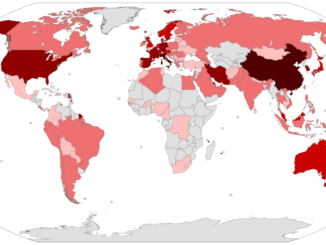
Be the first to comment